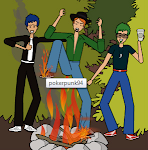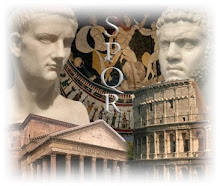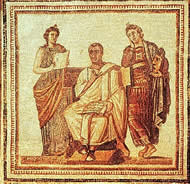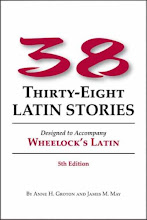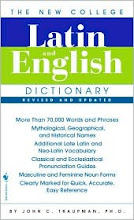Website of the Gods!!!
Thursday, December 31, 2009
Verb Chart Review
Present Am hitting/hits Is hit
Future Shall hit Shall be hit
Imperfect Was hitting Was hit
Perfect Has hit Has been hit
Future Perfect Will have hit Will have been hit
Pluperfect Had hit Had been hit
Wednesday, December 30, 2009
Virgil's 4th Eclogue Parsing-Review for Mid-Term
- Incipit-3rd person singular present active indicative of "incipere" meaning "to begin"
- Erunt-3rd person plural future active indicative of "esse" meaning "to be"
- Venit-3rd person singular present active indicative of "venire" meaning "to come"
- Liberabitur-3rd person singular future passive indicative of "liberare" meaning "to free"
- Videbit-3rd person singular future active indicative of "videre" meaning "to see"
- Videbitur-3rd person singular future passive indicative of "videre" meaning "to seem"
- Reget-3rd person singular future active indicative of "regere" meaning "to direct"
- Feret-3rd person singular future active indicative of "ferre" meaning "to bring"
- Poterit-3rd person singular future active indicative of "posse" meaning "to be able to"
- Parabunt-3rd person plural future active indicative of "parare" meaning "to prepare"
Tuesday, December 29, 2009
CH 27 SA Review
- It draws my new strength: I see more clearly, but I make so much worse and I do not know why.
- Certain songs are good; many are bad.
- He is the best. Nothing is better, I have seen nothing more beautiful than this.
- I hope you and this man's birthday and most others are about to drive with happiness.
- Since planning and reckoning are in old age, our ancestors called the senate our highest council.
- More effort and zeal should be put in domestic matters by us even in military matters.
- Neither was the danger graver in the republic, nor the laziness greater.
- We are wiser than those men, because we know nature is the best leader.
- Nature asks very little, but a wise man accommodates himself to nature.
- The greatest remedy for anger is delay.
- Which spirits he conquers and anger he contains I do not compare, but I say he is like a god.
- Dionysus, a tyrant of a most beautiful city, was a man of great temperance in his ways of life, and in all things was diligent and sharp. He too was fierce and unjust. Out of this affair, if we speak the truth, he seemed very wretched.
- If I cannot turn the gods, I shall disturb Acheron.
Monday, December 28, 2009
Spartacus-Who
Picture: http://www.s9.com/images/portraits/28569_Spartacus.jpg
Friday, December 25, 2009
Interesting Fact of Rome (7)
32. In the ninth century, Vikings were raiding Constantinople at the mouth of the Black Sea.
33. in 1014, Emperor Basil II wished to end the 40 year long war with the Bulgarians. He blinded all but 150 out of 15,00 prisoners, the 150 were blinded in only one eye, and sent them home with a one-eyed leader to Ohrid, whose ruler Samuel, had received word that his army was returning. He rushed to meet them, and at the sight of his thousands of blind men, Samuel suffered a stroke and died. Basil II received the title Baroktonis, meaning "slayer of Bulgarians."
P.S. Merry Christmas!!!
Picture: http://static-p4.fotolia.com/jpg/00/05/69/83/400_F_5698347_3m9W3rquzoXyQmXvcLul4SI7mLYbSV6M.jpg
Thursday, December 24, 2009
Interesting Facts of Rome (6)
27. In 554, Narses destroyed the Ostrogoths and took back Roman control of Italy. He was 90 years old.
28. Emperor Justinian bribed two Persian monks to take silkworm eggs and bring them back to Constantinople. Silk production began in 550 AD.
29. Since 5622, the Hagia Sophia cathedral at Constantinople has held the largest self-supporting dome, in an acting seismic region.
30. An authentic "lost weapon" is Greek fire, used in Constantinople against the Muslims in the seventh and ninth centuries.
Picture: http://static-p4.fotolia.com/jpg/00/05/69/83/400_F_5698347_3m9W3rquzoXyQmXvcLul4SI7mLYbSV6M.jpg
Wednesday, December 23, 2009
Interesting Facts of Rome (5)
22. The Byzantines never called themselves the Byzantines, the name came from Byzantium, the former name of the city Constantinople.
23. The Roman Empire and Persia signed "the Endless Peace" treaty in 533, and were at war seven years later.
24. In 534, Dennis the Little created the system of counting years still used today by starting with the birth of Christ.
25. In 537, Emperor Jutsinian held a banquet for which 6,000 sheep, 1,000 oxen, 1,000 pigs, 1,000 chickens, and 500 deer were slaughtered.
Picture: http://static-p4.fotolia.com/jpg/00/05/69/83/400_F_5698347_3m9W3rquzoXyQmXvcLul4SI7mLYbSV6M.jpg
Tuesday, December 22, 2009
Interesting Facts of Rome (4)
17. The Italian city Ravenna was on the coast of the Adriatic. Honorius made this city the capital of the Western Roman Empire.
18. Roman Emperor Theosdosius built a triple wall from the Golden Horn to the Sea of Marmara.
19. The word "mile" comes form the Roman milia meaning "thousands."
20. The Romans used poisonous led as a sweetening agent.
Picture:http://static-p4.fotolia.com/jpg/00/05/69/83/400_F_5698347_3m9W3rquzoXyQmXvcLul4SI7mLYbSV6M.jpg
Monday, December 21, 2009
Interesting Facts of Rome (3)
12. Emperor Commodus fought and won 11 battles in the gladiatorial arena.
13. One of the worst Roman emperors was Heliogabulus. He replaced the gods of Syrian Gods.
14. Dependence on slave labor was one of the downfalls of the Roman Empire.
15. In the fourth century, twenty great families in six large clans owned most of the land in Gaul
Picture: http://static-p4.fotolia.com/jpg/00/05/69/83/400_F_5698347_3m9W3rquzoXyQmXvcLul4SI7mLYbSV6M.jpg
Friday, December 18, 2009
Interesting Facts of Rome (2)
7. In the first hundred days of the Colosseum in Rome in 80 AD, over 5,000 animals were killed, including: elephants, tigers, lions, elks, hyenas, hippopotamuses, and giraffes.
8. The amount of people able to fit in the Colosseum is to be debated, but 45,000 is generally the accepted figure.
9. At the peak of the Roman Empire, the size of Rome was about the size that the US is now.
10. The empire was know together by 18,000 of roads.
Picture: http://static-p4.fotolia.com/jpg/00/05/69/83/400_F_
5698347_3m9W3rquzoXyQmXvcLul4SI7mLYbSV6M.jpg
Thursday, December 17, 2009
Interesting Facts of Rome (1)
2. Virgil's quest for perfection almost lead posterity not to inherit the Aeneid, as he did not wish for it to be published, but burned, as it was "not polished." Augustus stepped in and countermanded this request, and published the Aenied.
3. Gauis Caesar was so hated he was killed by one of his own gaurds.
4. Caligula had a favorite horse with a golden goblet for wine.
5. The first volume of recipes was first published in 62 AD by Apicius. It was titled De Re Coquinaria.
Picture: http://static-p4.fotolia.com/jpg/00/05/69/83/400_F_5698347_3m9W3rquzoXyQmXvcLul4SI7mLYbSV6M.jpg
Wednesday, December 16, 2009
When in Rome-When
Many often hear this phrase, but what does it really mean? The statement mean that when in new environments, try to follow the customs and traditions of the area, often used when speaking of heading to foreign countries. This is to avoid conflict that could arise from not knowing the culture. A popular story thought to hold the key to this mystery, is that when St. Augustine asked St. Ambrose to go on a mission to Rome, he didn't know what holy day to follow to fast, as Romans held it on a different day. St. Augustine wisely told Ambrose, "When in Rome, do as the Romans do."
Picture: http://i.dailymail.co.uk/i/pix/2008/04/28/article-1017063-0101159700000578-232_468x395.jpg
Tuesday, December 15, 2009
Hippocampi-What
Link: http://www.theoi.com/image/P12.4BThetis.jpg
Monday, December 14, 2009
SPQR-Who
Link: http://www.novaroma.org/vici/images/thumb/400px-Spqr-big-trans.gif
Friday, December 11, 2009
Titans-What
 The Titans were: Kronos, Koios, Krios, Hyperion, Iapetos, Okeanos, Ouranos, and Gaia. They ruled the cosmos before the Olympians came to power. Hyperion, Koios, Krios, and Iapetos were all posted at the 4 corners of the world, and the Cyclopes and Hekatonkheires were placed in the pit of Tartaros.
The Titans were: Kronos, Koios, Krios, Hyperion, Iapetos, Okeanos, Ouranos, and Gaia. They ruled the cosmos before the Olympians came to power. Hyperion, Koios, Krios, and Iapetos were all posted at the 4 corners of the world, and the Cyclopes and Hekatonkheires were placed in the pit of Tartaros.A prophecy was told that Kronos' children would overthrow him. Therefore, he ate all of his children as soon as they were born. When Zeus was born, Rhea gave to Kronos, the Titan-king, a rock to eat instead. When Zeus grew up he made Kronos disgorge his siblings, who, being immortal, were still alive. The gods then overthrew the Titans.
 Pictures: http://www.fashion-res.com/EX/10-08-03/The%2520Battle%2520Betwee
Pictures: http://www.fashion-res.com/EX/10-08-03/The%2520Battle%2520Between%2520the%2520Gods%2520a
nd%2520the%2520Titans.jpg
-http://www.theoi.com/Titan/
Titanes.html
Thursday, December 10, 2009
Latin (FAIL) Review for Mid-term *cough fail cough*
ID and translate each Ablative Absolute and Passive Periphrastic-> Sententiae Antiquae-> page159
1. Carthago delenda est-Passive Periphrastic
2. Asia victa-Ablative Absolute
3. Omnibus ferro militis perterritis-Ablative Absolute
4. Quidquid dicendum est-Ablative Absolute
5. Sananda sunt-Passive Periphrastic
6. Augusto terras tenente-Ablative Absolute
7. Tarquinio expulso-Ablative Absolute
8. Regenda sunt-Passive Periphrastic
B.
ID and Parse each participle-> Sententiae Antiquae-> page 152-> ex. laudans-present active participle
1. Oppressus- future passive participle
2. Tendentes-present passive participle
3. Sitiens-present active participle
4. Fugientia-present active participle
5. Futurarum-future active participle
6. Capta-perfect passive participle
7. Fugienti-present active participle
8. Educandum-future passive participle
9. Scripturus-future active participle
10. Dicturi-future active participle
11. Audituros-future active participle
12. Legens-present active participle
13. Factorum-future active participle
14. Timens-present active participle
15. Iussus-perfect passive participle
16. Emissum-perfect passive participle
C.
ID the verbs that introduce the indirect statements-> Sententiae Antiquae-> pages 167-168
1. Negavit
2. Pronuntiatis, scivisti
3. Sentis
4. Vidi
5. Cerno
6. Credo
7. Sciebam
8. Nuntiavit
9. Dico
10. Vidisse
11. Putabat
12. Negant
13. Negavi
14. Credo
15. Dicere
16. Aiunt
D.
ID and translate jussives-> Sententiae Antiquae-> page 191
1. Ducat-let it command
2. Cedant-let them concede
5. Rapiamus-
Wednesday, December 9, 2009
Temple of Peace-Where
Picture: http://intranet.arc.miami.edu/rjohn/images/RomeFora/Vespacian%20with%20Temple%20of%20Peace.jpg
Tuesday, December 8, 2009
79 AD-When
Picture: http://www.dogsofpompeii.com/images/pompeii_temple_of_jupiter.jpg
Monday, December 7, 2009
Ambigrams-What
For an ambigram generator, check out: http://www.flipscript.com/ambigram-generator.aspx
Sunday, December 6, 2009
Why Did Pygmies Fight Cranes?
Picture: http://www.theoi.com/Phylos/Pygmaioi.html
Thursday, December 3, 2009
Domus Augustana-Where
Picture: http://maquettes-historiques.net/R93.jpg
Wednesday, December 2, 2009
Definition of a Hero

A hero is one who makes a positive difference in someone else's life. This could be in the form of the garden variety superheroes like Superman, Spiderman, Wonder Woman, etc. It could also be one of the great heroes of Greek mythology, like Perseus, Heracles, and Achilles who are eventually deified. Then there are the less known heroes, the person who saves a child from a life of crime and redirects him towards good, or the person in the bank during the robbery who takes down the robber before he strikes, or all the policemen/policewomen and firefighters from 9/11, or the soldiers in Iraq who gave their lives for their country. A hero is one who is selfless for the good of others. Heroes may not always succeed. Maybe the man trying to stop the robber gets shot, but that doesn't make him any less of a hero. The thought and act of self-sacrifice, courage, altruism, and moral good were there.
Heroes are not the ones who score the game-winning touchdown or make the last goal in their soccer game to win it, they are the ordinary people who do extraordinary things. Heroes don't necessarily have to be the big, courageous, strong types either. The person who donates his time and efforts to Manna House, for example, is a hero of his own.
Heros are also not those who do the act of heroism just for the credit. They are those who never want the credit.
A hero is one who does great deeds for the benefit of others. A hero makes a difference.
Picture: http://sojournproject.files.wordpress.com/2009/06/super_hero.jpg
Tuesday, December 1, 2009
Satyrs-What

In Greek mythology, satyrs are deities of woods and mountains. They are half man, half goat. The upper half of the body is human, while the lower half has a goat's tail, flanks, and hooves. Even though the upper part of the body is human, they also have the horns of a goat. Many satyrs are the companions of Dionysus, god of wine. They spend their time drinking, dancing, and chasing nymphs.
Picture:http://www.elfwood.com/art/s/a/sarabean/satyrs.jpg
Monday, November 30, 2009
Chapter 28 Optional (yet not so optional) Exercises
- Other than fact, but could become fact
- More common
- -e, -a
- Jussive
- Purpose
- Jussive
- No
- Subjunctive labels
- He will send
- Subjunctive-3rd sing
- He is sending
- Subjunctive-3rd sing
- He gives
- Subjunctive-3rd plural
- They believe
- They will believe
- They move
- Subjunctive-3rd plural
- We shall be heard
- Subjunctive-1st plural
- We are heard
- Subjunctive-2nd sing
- You are seizing
- You will seize
- They are known
- They shall be known
- Subjunctive-3rd plural
- You are freed
- Subjunctive-2nd plural
- You will be freed
- They are destroyed
- Subjunctive-3rd plural
- You will be conquered
- You are conquered
- Subjunctive-2nd sing
- We say
- We shall say
- Subjunctive-1st plural
- Let the leader come. We are waiting for him.
- Let the lowly citizens depart from our state so that we may live in leisure.
Themis-Who

Themis was the Greek Titan goddess of divine law and order (the traditional rules of conduct first established by the gods). She was also a prophetic goddess who presided over Delphoi. Themis was the divine voice (themistes). She first instructed mankind in the primal laws of justice and morality. Themis was an early bride of Zeus, and is often represented seated next to him, advising him.
Picture:http://www.theoi.com/image/T8.1Themis.jpg
Chapter 28 SA
- Let reason lead, not luck.
- Let arms yield to the toga.
- Leave the city so that I might not be suppressed by fear and weapons.
- One thin must be done immediately in order to have the greatest peace and solace.
- Let us take the opportunity from the day, my friends.
Friday, November 27, 2009
Why did Talos Patrol the Island?

Talos was a giant, living bronze automaton. He was forged by Hephaestus, and Zeus presented him to his lover Europa to protect her. Zeus then sent Europa to the island to Crete, where Talos patrolled the shores for pirates, etc. 3 times a day. If anyone tried landing, he would pelt them with rocks or put them in a a fiery death embrace. Talos was eventually killed with magic from Medea.
Picture: http://goremasterfx.files.wordpress.com/2009/08/talos.jpg
Thursday, November 26, 2009
The Temple of Heliogabulus-Where

The Temple of Heliogabulus was dedicated to the Syrian sun god Heliogabulus. It was built near the imperial palace on the Palatine. It was built by the emperor Elagabulus. Elagabulus moved sacred objects from Roman temples to here. After Elagabulus' assassination, Alexander Severus rededicated the temple to Jupiter Ultor (Jupiter "the Avenger")
Picture: http://www.psy.ritsumei.ac.jp/~akitaoka/sun.jpg
Wednesday, November 25, 2009
First Samnite War (343-341 BC)-When

This war was fought between the Roman Republic and Samnium. The First Samnite War was short, and was marked by Roman victories. This ended after 2 years with the Romans winning over the Samnites. The war with these hill people was ended in a hasty peace, as the Romans were also dealing with other tribes trying to fight Rome.
Picture: http://www.heritage-history.com/books/church/rome/front2.gif
Tuesday, November 24, 2009
Manticore-What
Monday, November 23, 2009
Psyche-Who

Psyche was the goddess of the soul. She was the wife of Eros, the god of love. Psyche was once a mortal princess. Her astounding beauty caught the attention of Aphrodite, who wished that she would fall in love with the most hideous of men. However, Eros fell in love with her and took her to his secret place. Psyche was not to look Eros in the face, but she did. He then abandoned her. She searched all over till she found Aphrodite, who made her so many tasks. In the end, Eros and Psyche were reunited and wed in a ceremony attended by the gods.
Picture: http://shalottianshards.files.wordpress.com/2009/02/gerard_francoispascalsimon-cupid_psyche_end.jpg
Friday, November 20, 2009
Why Pasiphae Married a Bull

Pasiphae was the immortal daughter of the sun god Helios. Pasiphae wed King Minos of Crete. As punishment for an offense to the gods from either Pasiphae or Minos, Pasiphae was cursed with the desire for Minos' finest bull. The Queen had Daidalos make a mechanical bull, endowed with mechanical life. Pasiphae conceived and bore a hybrid child, which came to be known as the Minotaur.
Picture: http://www.explorecrete.com/history/images/pasiphae-minos.jpg
Thursday, November 19, 2009
"Q" Quiz
2. quam-how
3. quando-when
4. quare-therefore
5. quid-who
6. quidem-certainly
7. quin-indeed
8. quin etiam-in fact
9. quo-where
10. quomodo-how
11. quondam-certain
12. quoque-also
13. veritas-truth
14. superbus-arrogant
15. lux-light
16. credere-I believe
17. nescere-to sin
18. sperare-to hope
19. expellere-to expel
20. MMIX
House of Vesta-Where
Wednesday, November 18, 2009
An Uncle's Love for his Nephew and Adopted Son
This young man is more precious than I myself am. Also, this man is not from me, but is from my brother. The enthusiasms of my brother are soon still further unlike mine. I have urged my life in the city and I have aimed at peace, that which some consider fortunate, I have never had a wife. But he has done these: he led a life not in the forum, but the fields, he received little money, married a chaste wife, and had two sons. From him I adopted the older one for me myself. I reared him from a small boy, I have loved him as my own. In that young man is my enjoyment; it alone is dear to me
Tuesday, November 17, 2009
Chapter 27-S.A.
- He draws my new strength: I see better and I approve, but I make so much worse and I do not know why.
- Certain songs are good; many are bad.
- He is the best. Nothing is better, I have seen nothing more beautiful than this.
- I hope you and this man's birthday and most others are about to drive with happiness.
- Since planning and reckoning are in old age, our ancestors called the senate our highest council.
- More effort and zeal should be put in domestic matters by us even in military matters.
- Neither was the danger graver in the republic, nor the laziness greater.
- We are wiser than those men, because we know nature is the best leader.
- Nature asks very little, but a wise man accommodates himself to nature.
- The greatest remedy for anger is delay.
- Which spirits he conquers and anger he contains I do not compare, but I say he is like a god.
- Dionysus, a tyrant of a most beautiful city, was a man of great temperance in his ways of life, and in all things was diligent and sharp. He too was fierce and unjust. Out of this affair, if we speak the truth, he seemed very wretched.
- If I cannot turn the gods, I shall disturb Acheron.
Monday, November 16, 2009
Pandora-Who

Pandora was the first woman, who was formed out of the clay by gods. Prometheus was assigned the task of creating man, but was displeased and stole fire from heaven. Zeus commanded Hephaestus and the other gods to makes her beautiful and cunning. Pandora was then delivered to Epimetheus, Prometheus' foolish brother, and they were married. As a wedding gift, Zeus gave them a box, or pithos (storage jar). They opened the jar, unleashing a swarm of evils spirits on the world. Only hope (elpis)was left in the box. Pandora's daughter Pyrrha was the first-born mortal child.
Picture: http://abooali.files.wordpress.com/2008/12/pandora.jpg
Friday, November 13, 2009
Top Tens!-Annotated Lists
Ancient Celt/Gaul Culture
- Grant, Neil. Everyday Life of the Celts Uncovering History. Black Rabbit Books, 2004. Google Books. Google, 2009. Web. 16 Nov. 2009. <http://books.google.com/books?id=YCV41ImfLvMC&dq=Celt+Armor&lr=&source=gbs_navlinks_s>.
This is an incredibly useful source, with much information and colorful pictures on the Celts. It describes the everyday life of the Celts.
*****
- Mallory, J. P., and Douglas Q. Adams. Encyclopedia of Indo-European Culture. Taylor & Francis, 1997. Google Books. Google, 2009. Web. 16 Nov. 2009. <http://books.google.com/books?id=tzU3RIV2BWIC&dq=Ancient+Celtic+Culture&lr=&source=gbs_navlinks_s>.
This is a website with background on the Indo-European Culture, which formed into what became the Celts. Some of this background is needed to understand the growth of Gaul and the Celts over the years.
****
- Holcomb, Melanie. "Barbarians and Romans". In Heilbrunn Timeline of Art History. New York: The Metropolitan Museum of Art, 2000–. http://www.metmuseum.org/toah/hd/barb/hd_barb.htm (October 2002)
This Met Museum site talks about the relationship between Rome and the Germanic tribes, including the Celts. This gives background for the diplomatic relations between the tribes and Rome.
****
- "The Celtic Influence." BBC. BBC, 23 May 2009. Web. 16 Nov. 2009. <http://www.bbc.co.uk/irish/articles/view/720/english/>.
This BBC source describes who the Celts are and how they influence others. It goes specifically into the Celt and Romans.
****
- Green, Miranda J. The Celtic World. Routledge, 1996. Google Books. Google, 2009. Web. 16 Nov. 2009. <http://books.google.com/books?hl=en&lr=&id=DeV3EZKzcqUC&oi=fnd&pg=PA21&dq=Celt+War&ots=28PIepWakP&sig=aJLRfMMSTkF9QPQGdUPhV4gLRJQ#v=onepage&q=Celt%20War&f=false>.
This Google Book has details on the Celtic Culture. It also talks about art of the time and its relation to the Celtic Culture.
****
- Smith, A. G. Life in Celtic Times. Courier Dover Publications, 1997. Google Books. Google, 2009. Web. 16 Nov. 2009. <http://books.google.com/books?hl=en&lr=&id=GHwtqUcfy-UC&oi=fnd&pg=PA5&dq=Ancient+Celt+Armor&ots=fq6iVWQKsn&sig=C3sWcYhSFMVfvUIl-L8Cs_oBFBI#v=onepage&q=&f=false>.
This source details the life in Celtic times. It includes illustrations, as a picture is worth 1000 words.
****
- Mountain, Harry. The Celtic Encyclopedia. Universal-Publishers, 1998. Google Books. Google, 2009. Web. 16 Nov. 2009. <http://books.google.com/books?hl=en&lr=&id=LTbc1GIAwcIC&oi=fnd&pg=PA3&dq=Celt+Armor&ots=_tZ-RH4rPZ&sig=zfvvRS5HbprtbVgI8Q6b2I9aTGs#v=onepage&q=&f=false>.
This is the Celtic Encyclopedia. It includes a very helpful timeline on the Celts.
****
- Duffy, Kevin. Who were the Celts? Barnes and Noble, 19990760716080, 9780760716083. Google Books. Google, 2009. Web. 16 Nov. 2009. <http://books.google.com/books?hl=en&lr=&id=_f3YvBLtPTAC&oi=fnd&pg=PR9&dq=Celt+Armor&ots=QKJYTK1qLV&sig=yCOmroUovJF63jqBShjxbDVIhyk#v=onepage&q=&f=false>.
This site answers the question "Who are the Celts?" It includes historic encounters between Rome and the Celts.
****
- Markale, Jean. Women of the Celts. Inner Traditions/Bear & Company, 1986. Google Books. Google, 2009. Web. 16 Nov. 2009. <http://books.google.com/books?hl=en&lr=&id=4UVc6up1HJUC&oi=fnd&pg=PA9&dq=Celt+Legends&ots=lPDAhd1MMu&sig=J64o9CL7Cwf52NIeFlIZf_ytH7Y#v=onepage&q=Celt%20Legends&f=falseG>.
This Google Book has to do with Celtic Culture. More, specifically, it speak about the women of the Celts.
***
- Harvey, David. Celtic geographies: old culture, new times. Routledge, 2002. Google Books. Google, 2009. Web. 16 Nov. 2009. <http://books.google.com/books?id=uKwLgFCX5RAC&dq=Celtic+Culture&lr=&source=gbs_navlinks_s>.
Describes old ways as well as new, changed ways. This Google Book also explores Celtic geography.
****
Celt and Gaul Weapons and Warfare
- "Terret (Rein Guide) [Celtic; Britain] (1988.79)". In Heilbrunn Timeline of Art History. New York: The Metropolitan Museum of Art, 2000–. http://www.metmuseum.org/toah/ho/05/euw/ho_1988.79.htm (October 2006)
The Celts used chariots in warfare. This was legendary, and this piece of art helps to recreate the history.
*****
- Caesar, Julius, and Arthur T. Walker. Caesar's Gallic War: Books I-IV. Scott, Foresman and company, 1907. Google Books. Google, 2009. Web. 16 Nov. 2009. <http://books.google.com/books?id=A7pEAAAAIAAJ&source=gbs_navlinks_s>.
This Google Book is on the Gallic Wars. It includes pictures to further tell the story.
****
- "Western and Central Europe, 1000 B.C.–1 A.D.". In Heilbrunn Timeline of Art History. New York: The Metropolitan Museum of Art, 2000–. http://www.metmuseum.org/toah/ht/04/euw/ht04euw.htm (October 2000)
This is a timeline of Western and Central Europe and the Celtic Cultures. Is also puts a date on the confrontation with Rome.
****
- Chasseriau, Theodore. Scene from the Gallic Wars: The Gaul Littavicus, Betraying the Roman Cause, Flees to Gergovie to Support Vercingétorix. 1838-1840. Metropolitan Museum of Art, Paris. Heilbrunn Timeline of Art History. The Metropolitan Museum of Art, 2009. Web. 16 Nov. 2009. <http://www.metmuseum.org/Works_of_Art/collection_database/european_paintings/scene_from_the_gallic_wars_the_gaul_littavicus_betraying_theodore_chasseriau/objectview.aspx?OID=110003239&collID=11&dd1=11>.
This is a Met Museum scene of the Gallic Wars. It is an oil on canvas painting.
****
- "History of the Celts." BBC. BBC, 23 Nov. 1999. Web. 16 Nov. 2009. <http://www.bbc.co.uk/dna/h2g2/A207479>.
This is a timeline of the Celtic Culture, and follows it over a span of 2500 years! This details the violence between the Romans and Celts.
****
- Jimenez, Ramon L. Caesar against the Celts. Da Capo, 1996. Google Books. Google, 2009. Web. 16 Nov. 2009. <http://books.google.com/books?id=c9eujq4oiLIC&dq=Celt+Armor&lr=&source=gbs_navlinks_s>.
This source talks of Caesar's attitude against the Celts. It goes into the details of the Gallic Wars.
****
- Caesar, Julius, and Arthur T. Walker. Caesar's Gallic War: Books I-IV. Scott, Foresman and company, 1907. Google Books. Google, 2009. Web. 16 Nov. 2009. <http://books.google.com/books?id=A7pEAAAAIAAJ&source=gbs_navlinks_s>.
This is a link on Caesar's Gallic Wars, books 1-4. It includes a preface on Caesar.
****
- Versteeg, Russ. Law and Justice in Caesar's Gallic Wars. HeinOnline. 2005. Web. 16 Nov. 2009. <http://heinonline.org/HOL/LandingPage?collection=journals&handle=hein.journals/hoflr33&div=22&id=&page=>.
This source speaks on the laws and justice of Caesar's Gallic Wars. It includes helpful background information.
****
- Duffy, Kevin. Who Were Those Celts?: Everything You Ever Wanted to Know About the Celts. Heritage Books19, 1996. Google Books. Google, 2009. Web. 16 Nov. 2009. <http://books.google.com/books?hl=en&lr=&id=WzEM8TjDa6UC&oi=fnd&pg=PR9&dq=Celt+Armor&ots=Wo1eAK1zx8&sig=_XDIAzAo5MuG8MX3buyGE1hFzcs#v=onepage&q=War&f=false>.
This Google Book source talks of the Celts and their relations to other Cultures. It goes into some detail on the wars of the Celts.
***
- Ellis, Peter B. The ancient world of the Celts. Barnes and Noble, 1999. Google Books. Google, 2009. Web. 16 Nov. 2009. <http://books.google.com/books?hl=en&lr=&id=L9gMHcZCi1IC&oi=fnd&pg=PA7&dq=Celt+weapons&ots=yPv1eW8IC2&sig=ucsqwjIqmg9aixuyI-96MR0CjWw#v=onepage&q=Celt%20weapons&f=false>.
This link goes a little into the Celtic culture in relation to war. It also includes some pictures.
***
Celt and Gaul Mythology
- Squire, Charles. Celtic Myth and Legend. Courier Dover Publications, 2003. Google Books. Google, 2009. Web. 16 Nov. 2009. <http://books.google.com/books?hl=en&lr=&id=6-g5zu5oBg4C&oi=fnd&pg=PA1&dq=Ancient+Celtic+Mythology&ots=e9oVXD41Yi&sig=HRFiC3h_C4cWt6BYnUyO6jlCW7U#v=onepage&q=Ancient%20Celtic%20Mythology&f=false>.
This is a Google Book on Celtic Mythology and Legend. Mythology is an important aspect to understanding culture.
****
- Squire, Charles. Celtic Myth and Legend Poetry and Romance. Kessinger, 2006. Google Books. Google, 2009. Web. 16 Nov. 2009. <http://books.google.com/books?hl=en&lr=&id=jeJJiKop6REC&oi=fnd&pg=PA1&dq=Ancient+Celtic+Mythology&ots=atoWDca2Ni&sig=TpTzozWN0kdnIKS7kFFdE4RvzcM#v=onepage&q=Ancient%20Celtic%20Mythology&f=falseGoogle>.
This Google Book deals more directly with Celtic mythology in the British Islands. This is a little more specific, but shows how Celtic Culture has influenced the British Islands.
****
- RollestonN, T. W. Myths and Legends of the Celtic Race. Cosimo, Inc., 2009. Google Books. Google, 2009. Web. 16 Nov. 2009. <http://books.google.com/books?hl=en&lr=&id=IutjLHJzHCAC&oi=fnd&pg=PA17&dq=Celt+Legends&ots=BIs1pSZJbo&sig=hn_3elkTDmAjKKSbQ_UQFyzdF0A#v=onepage&q=Celt%20Legends&f=false>.
This Google Book is on Myths and Legends of the Celts. It also speaks a little on the Celts in ancient history.
****
- MacCulloch, John A., Jan Machal, and Louis H. Gray. Celtic mythology. Marshall Jones Company, 1918. Google Books. Google, 2009. Web. 16 Nov. 2009. <http://books.google.com/books?hl=en&lr=&id=-pYYAAAAIAAJ&oi=fnd&pg=PA1&dq=Celtic+Legends&ots=ae7visZvGQ&sig=SWkZcIVsDty74FgSKV2m82vhDlc#v=onepage&q=Celtic%20Legends&f=false>.
This is another Google book on the Celtic Myths. This one, though, has illustrations to help fully describe the Celtic Culture.
****
- Ellis, Peter B. Celtic myths and legends. Carroll & Graf, 2002. Google Books. Google, 2009. Web. 16 Nov. 2009. <http://books.google.com/books?hl=en&lr=&id=rsPNup_a2owC&oi=fnd&pg=PA1&dq=Celtic+Legends&ots=lOvvNbygZH&sig=wYuXa73GnFfhifyLPBDJaNnCK2c#v=onepage&q=&f=false>.
This is a Google Book document on Celtic myths and legends. It includes an introduction with information on the Indo-European Culture.
****
- Green, Miranda J. Animals in Celtic life and myth. Routledge, 1998. Google Books. Google, 2009. Web. 16 Nov. 2009. <http://books.google.com/books?hl=en&lr=&id=hLOXNZoBhsQC&oi=fnd&pg=PR9&dq=Celtic+Mythology&ots=zxzacjJGBz&sig=u0TQPIPMOo8c6INApYQGVPlwbE0#v=onepage&q=Celtic%20Mythology&f=false>.
This source is a Google Book on Celtic Myth. More specifically, it is on animals in Celtic life and myth.
****
- Macbain, Alexander. Celtic Mythology and Religion. Kessinger, 2003. Google Books. Google, 2009. Web. 16 Nov. 2009. <http://books.google.com/books?hl=en&lr=&id=DbwJmL1I4h4C&oi=fnd&pg=PR5&dq=Celtic+Mythology&ots=suMfPTJurO&sig=dpbQKEwTXo5FytU6qrnMQwomNnE#v=onepage&q=&f=false>.
This source is on Celtic Mythology. More specifically, it's on mythology in relation to religion.
****
- Monaghan, Patricia. The Red-Haired Girl from the Bog: The Landscape of Celtic Myth and Spirit. New World Library, 2004. Google Books. Google, 2009. Web. 16 Nov. 2009. <http://books.google.com/books?hl=en&lr=&id=3jz2yYtGXnAC&oi=fnd&pg=PA167&dq=Celtic+Mythology&ots=FvPXg2t4zE&sig=3B3TvenTsiaPTIIf9H0rQD9bHbs#v=onepage&q=Celtic%20Mythology&f=false>.
This Google Book source talks about the landscape of Celtic Myth. It detail the red haired girl form the bog.
****
- Koch, John T. Celtic Culture: a historical encyclopedia. ABC-CLIO, 2006. Google Books. Google, 2009. Web. 16 Nov. 2009. <http://books.google.com/books?id=f899xH_quaMC&printsec=frontcover&dq=Celt+Culture&lr=#v=onepage&q=Celt%20mythology&f=false>.
This Google Book is an Encyclopedia. It goes into some detail on Celtic Mythology.
***
- Rolleston, T. W. Celtic Myths and Legends. Courier Dover Publications, 1990. Google Books. Google, 2009. Web. 16 Nov. 2009. <http://books.google.com/books?hl=en&lr=&id=4CUS2j5fw-QC&oi=fnd&pg=PA94&dq=Celt+Legends&ots=rA1R36LKP2&sig=z2gUQDFAWF-sfJEOGCyA2hcA8CY#v=onepage&q=Celt%20Legends&f=false22>.
This is another Google Book on Celtic Myths and Legends. It also details the Irish invasion myths.
***
























